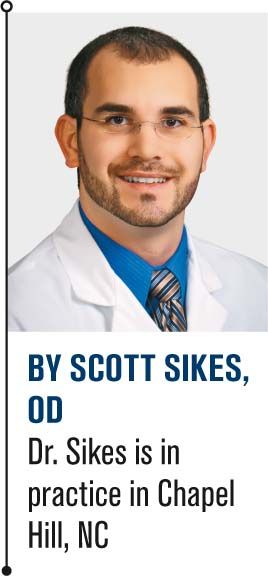Optometry must change with the times
The general public as well as some ODs have forgotten the extend of our core training. We have to educate our patients more thoroughly about why we do what we do and why it matters that they have an annual eye exam.


Whenever I am in a group of optometrists, it seems the hot topic of conversation is online optical sales. Who lost a sale to which online company, how much money is being lost, the bad quality, the list goes on and on.
So, let’s get this out of the way. I choose not to worry about online product sales. No matter how much I try to educate my patients on quality concerns or how many times I adjust my pricing to be more competitive, it will just never work.
Online sales aren’t going anywhere. If anything, I believe they will become more prevalent with time as technology increases. The question becomes, what now?
When it makes sense
No one wants to shut down his optical or abandon contact lenses completely because glasses and contact lenses are needed by patients and they are a portion of our livelihood as optometrists. So, what do we do?
I still educate my patients on the differences between high quality and thereby more expensive materials vs. lower quality, less expensive options. Let’s face it, you get what you pay for. Having said that, if your -1.00 D sphere OU patient likely won’t notice as much difference as a high prescription progressive patient.
Previously from Dr. Sikes: Tips and tricks for utilizing EHR
I also educate patients there is a time and place for everything. I have a fairly large contact lens-wearing patient base who has no intention of wearing glasses unless absolutely necessary. I have frequently been told, “I wear my contact lenses only and don’t own a pair of glasses.” While I understand their point of view, I don’t have to agree with it. This is an instance in which online glasses sales might make sense. An inexpensive back-up pair of glasses is much better than no glasses and the increased risk to eye health with contact lens abuse. Would I like to sell them the glasses too? Of course, who wouldn’t? However, I don’t have frame and lens packages in my office that start at $6.95.
Capture rate
We can’t compete with online sales, and we shouldn’t try. I still value glasses and contact lens sales. We try to accommodate as many patients as possible with a variety of pricing and style choices, but no matter what you do you’ll never have a 100 percent capture rate.

According to VSP, “A good capture rate targets 70 percent to 80 percent or better. This number will never be 100 percent because you will have patients without prescriptions or there will be contact lens patients who already have adequate back-up glasses. There will be patients that have no prescription change. The goal is not to focus on the number and ‘100 percent of patients who come in’ but to satisfy all potential buyers’ varying eyewear needs.”1
Per VSP, private practices see a capture rate of 50 percent to 60 percent.1 Our office capture rate is about 65 percent.
Patient education works
I think the general public as well as some optometrists have forgotten our core training. We are doctors of optometry. We are trained to diagnose and treat medical eye conditions. In recent history, contact lenses in particular have become a mere commodity and are no longer perceived as a medical device. Patients don’t want to be bothered with coming to your office for what they see as a pointless exam just so they can order more lenses online.
This is where I think we have failed our profession. We have to educate our patients more thoroughly about why we do what we do and why it matters that they have an annual eye exam.
I have found that narrating my exam tells the patient what I’m looking for. Then I can explain in detail items of importance or answer specific questions. Unless you have a scribe, I don’t recommend calling out every single thing you are checking, but pick a few key factors and mention those to each patient. Even if everything is clear and normal, let her know. A simple statement such as, “I don’t see signs of cataracts, glaucoma, or macular degeneration” covers the majority of patient concerns.
I have taken to mentioning general systemic conditions that we can diagnose through dilated exams or widefield imaging techniques. Frequently when I mention that I am looking for diabetes, high blood pressure, high cholesterol, and the like while conducting a “routine” eye exam, patients become more engaged and begin to understand the importance of annual exams.
I usually hear patients say, “You can see all that in my eyes?”
Yes. Yes, we can.
Changing practice
My practice focus has shifted to more medical eye care. I spend more time educating patients about eye health and systemic correlations and less time discussing glasses. We can no longer rely solely on our background of optical and contact lens sales to support our profession. We have to stay current.
Related: Overcoming our fear of change
If we want our profession to remain strong, we have to make advances in our mode of practice. We should look at states like Oklahoma, Kentucky, and Louisiana and aspire to achieve legislation that allows all optometrists to practice to the full extent of our knowledge and training. To that point, all U.S. optometry schools are, at some level, already teaching these advanced procedures to their current students.

In my office, we manage all traditional ocular diseases such as glaucoma, macular degeneration, as well as chronic dry eye, foreign body removal, and when needed injections for chalazion/hordeolum. In the future, I hope to practice to the full extent of my training-I have taken additional continuing education courses on injections, benign eyelid lesion removal, and laser procedures including YAG laser, selective laser trabeculoplasty (SLT), and argon laser trabeculoplasty (ALT).
Our office is preparing for the future of optometry, and so should yours. Never forget that we are doctors of optometry. Just as other professions morph and change with time, we have to do the same. If we aren’t moving forward, we will be left behind.
Reference
1. VSP Spark. Available at: https://vspglobal.com/dms-inline/pdf/4507DR-VSP-Global-Spark-Tutorial_F.pdf. Accessed 3/26/18.
Newsletter
Want more insights like this? Subscribe to Optometry Times and get clinical pearls and practice tips delivered straight to your inbox.
